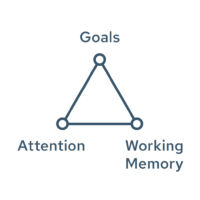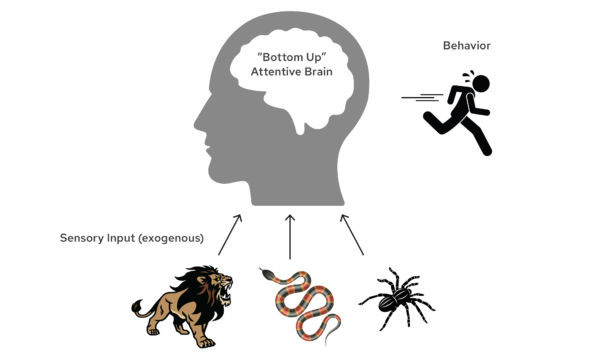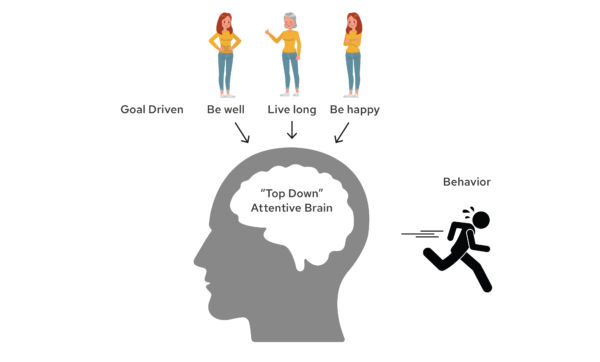Imagine you’re sitting in a meeting for work. Your boss is talking about planning for the next quarter. You have a notebook out and you’re scribbling notes. Then, you hear a ding from your phone, which is lying face-down on the table next to you. You start to wonder who it’s from, what it’s about, and if you need to check it. You quickly glance at it to make sure it’s not something pressing. In the time since you first heard the ding, you’ve completely switched gears in your brain and missed several minutes of discussion on the next quarter’s goals.
 In the digital world, this kind of distraction is an everyday experience for most people. But distractions don’t only come in the form of a notification or a ring. You might look outside and see it’s raining and start to wonder if your son remembered his jacket. You might think of an errand you forgot to run and start planning out when you’re going to make time for it later. Maybe someone bumps your car on your way to work, or you spill your coffee on your shirt.
In the digital world, this kind of distraction is an everyday experience for most people. But distractions don’t only come in the form of a notification or a ring. You might look outside and see it’s raining and start to wonder if your son remembered his jacket. You might think of an errand you forgot to run and start planning out when you’re going to make time for it later. Maybe someone bumps your car on your way to work, or you spill your coffee on your shirt.
When your thoughts are pulled in different directions like this, your brain cannot perform at its peak. Little distractions culminate and build up a kind of interference in your mind that inhibits its function throughout the day. Think about it: typically, when you wake up in the morning, your brain is “fresh”; it’s at its highest potential after a night’s rest. But as you move through your day, these distractions — dings, accidents, irritations — start to lower that potential. You start trying to multitask. The result is an inability to fully attend to one given task, and you end up failing to operate at peak brain performance.
So, what is peak brain performance? According to Dr. Sita Kedia, neurologist at PALM Health, “Peak brain performance is having optimal cognitive functioning — from memory to processing speed to decision-making and more.” Your brain is in charge of every function in the body, so it has a lot of other responsibilities of its own. But cognition, specifically, refers to those task-oriented skills.
 Optimal cognition and processing rely on three pillars: goal-setting, working memory, and attention. Together, they make up your cognitive control, a function that is required for you to process and execute tasks. When your brain is in peak performance, those three elements are working seamlessly together and are doing what they need to do in order for you to complete a task to the best of your ability, whether that’s finishing an important work project, acing an exam, or anything else. When one of these pillars is lacking or missing, that’s when you start having trouble following through and completing tasks well.
Optimal cognition and processing rely on three pillars: goal-setting, working memory, and attention. Together, they make up your cognitive control, a function that is required for you to process and execute tasks. When your brain is in peak performance, those three elements are working seamlessly together and are doing what they need to do in order for you to complete a task to the best of your ability, whether that’s finishing an important work project, acing an exam, or anything else. When one of these pillars is lacking or missing, that’s when you start having trouble following through and completing tasks well.
Goal-Setting
When you want to perform well in whatever task is at hand, you set forth a goal. Your goal determines how and where your attention and working memory are directed as you work towards it. Thus, varying goals will bring varying results.
For example, if you have a presentation at work coming up and your goal is to ace it and get a promotion, your attention and working memory as you prepare for and give the presentation will be directed towards that result and you’ll be highly focused on it. But if you just want to get through the presentation to have it over with and be free to attend a social event later that evening, you likely won’t achieve those high results because your attention and working memory aren’t directed towards it.
Working Memory
The second pillar of cognitive control is working memory. This is your brain’s ability to hold a piece of information and actively work with it. For example, if you were asked to count down from one hundred by sevens, it’s your working memory that is in charge of remembering each number to subtract from as you go. Reading comprehension is another example of working memory: your brain holds onto the information you read about so you can do something with it.
Working memory is essential in decision-making and goal-oriented tasks. Let’s say you’re planning a party for your friend. Your working memory is what allows you to think through all of the details and make decisions: how many plates will you need? What kind of food does your friend like? Last time, maybe you forgot candles for the cake, so you’ll make sure you have them this time. Without working memory, you would simply rely on automatic responses. Maybe you’d get a cake because that’s what people have at parties, but you’d forget everything else.
Thus, working memory allows your brain to actually do the work when performing a task.
Attention
Attention, as you’re likely familiar with, is the act of pointing your cognitive efforts toward something specific. But did you know there are two separate types of attention that govern different tasks in your brain? These are bottom-up attention and top-down attention.
Bottom-Up Attention
Also known as “stimulus-driven” attention, bottom-up refers to the way you attend to your environment in response to external, sensory observations. This form of attention is an evolutionary adaptation, being a key aspect of human survival long ago. It helped people avoid danger and toxins by responding appropriately to sensed threats.
These days, bottom-up attention can present in simpler, everyday situations. For example, it is the stimuli in your environment that stand out and grasp your attention, such as horns, sirens, dings on your phone, or the doorbell. If someone honks at you while you’re driving, you are going to react automatically by looking in the direction of the honk, or perhaps by moving out of the way or taking your foot off the accelerator. If you hear a notification on your phone, you will look at your phone and read it because it has become automatic to check it and you can’t ignore it.
Top-Down Attention
On the other hand, top-down attention describes how your goals dictate what you attend to. This is the most advanced form of attention. It involves your prefrontal cortex, the most evolved part of the mammalian brain. As discussed earlier, if you have a specific and strong goal that you’re dedicated to, such as getting a promotion, acing an exam, or taking a trip, you’re more likely to be highly focused in completing the tasks for that goal.
This is top-down attention at play. With this type of attention, you’ll study harder, concentrate more intensely in meetings, or plan more meticulously.
How Goals, Working Memory, and Attention Interact
So, why is it important for all three points of the cognitive control triad to function together?
Bottom-up attention, especially in the modern world, can easily result in distractions from your task at hand. If your bottom-up attention alerts you of a text on your phone and you pick it up, or if you hear rain outside and attend to it by wondering if your son remembered his rain jacket, your bottom-up attention has caused you to lose focus. If you latch onto those distractions and begin to entertain them, it may result in an attempt to multitask, which interferes with your top-down attention.
Because of the role of goals in cognitive control, having a goal that doesn’t align with the actions you’re doing can also interfere with your attention and working memory and lead to you start multitasking. “If your goal is to make it to your gathering with friends after your big presentation, but you’re still trying to prepare and practice for the presentation, chances are you’re going to be distracted,” says Dr. Kedia. You may be looking at your notecards but thinking about what dish you should bring tonight. You might stop in the middle of practicing to text your friend asking what time you should come.
 “When you multitask like this, you actually break down the neurological connection network your brain was building while you were working on your presentation,” says Dr. Kedia. The second you switch gears to send a text or try to do something else (yes, no matter how quick it is), your brain loses its network from the presentation and builds a new one while you’re texting. That’s why oftentimes you’ll look away from your work, send a quick text, then think, “wait, where was I?” Now your brain has to start over rebuilding the network related to your work.
“When you multitask like this, you actually break down the neurological connection network your brain was building while you were working on your presentation,” says Dr. Kedia. The second you switch gears to send a text or try to do something else (yes, no matter how quick it is), your brain loses its network from the presentation and builds a new one while you’re texting. That’s why oftentimes you’ll look away from your work, send a quick text, then think, “wait, where was I?” Now your brain has to start over rebuilding the network related to your work.
Your brain is always in conflict between bottom-up and top-down attention, which are influenced by your goals and in turn determine where your working memory is used. In order to perform tasks well and help your brain function at its highest level, you have to know how to navigate your own cognitive control triad.
Hacking Your Brain
Understanding how your brain’s cognitive control works is like being let in on a secret. Now, you can use that knowledge to hack your brain and intentionally give yourself guidelines for staying focused.
 Minimize Interference and Distractions
Minimize Interference and Distractions
When you’re working on a task, regardless of whether it is for work, for school, or in your personal life, eliminate any distractions that will cause interference with the networks in your brain that are being built up to help you complete your task.
Put your phone and computer on Do Not Disturb or turn off your ringer. Turn off notifications. Keep the TV off in the background.
Avoid Multitasking
When you’re working on one thing, give it your full attention. Your brain is not capable of completely dedicating itself to more than one task, and if you try to do that, some amount of information or knowledge will always get lost.
If you do hear a ding from your phone or if you hear a noise around you that might make you start thinking about something else, try to ignore it. Don’t answer the text. Let the distraction float by and move on. If you’re with a friend, family member, or coworker, be fully present with them.
Work on Goal-Setting
Strong goals are essential for high brain performance. Because your goal typically determines the direction of your attention and working memory as well as the intensity, it’s important to form a clear goal with the true intention of achieving it in order to succeed.
If your goal is to knock your presentation out of the park and get the promotion that depends on it — and if that goal is truly meaningful to you — distractions that lead to multitasking are less likely to get you so far off track. You may not even notice those distractions at all. Learn more about strong goal setting in our article Find the “Why” Behind Your Goals.
 Learn Stress Management Techniques
Learn Stress Management Techniques
Your brain has a section, called the amygdala, that is in charge of your emotions. When you experience negative feelings like fear, stress, and worry, your amygdala becomes overactive and tends to lead to emotional reactions. When it’s overactive like this, your amygdala can actually hijack your prefrontal cortex, the part of your brain that controls your top-down attention.
“Fear, stress, and worry interfere with your brain performance in a similar way that distractions do,” says Dr. Kedia. When you go through your day and experience aggressors like the crying child, the spilled coffee, and the bumped car, your brain loses charge bit by bit and your cognitive capacity for focus and performance goes down.
 To keep those negative emotions at bay, to help your brain stay charged longer, and to support your brain’s ability to function at its peak, managing stress is key. Meditation and breathing techniques can engage your parasympathetic nervous system, calming you down. Exercise and wellness therapies like cryotherapy, infrared sauna, and Himalayan salt sessions release endorphins, detoxify the body, and promote relaxation, which are all helpful for stress. Read Finding Your Stress Management Skill Set for more tips on stress management.
To keep those negative emotions at bay, to help your brain stay charged longer, and to support your brain’s ability to function at its peak, managing stress is key. Meditation and breathing techniques can engage your parasympathetic nervous system, calming you down. Exercise and wellness therapies like cryotherapy, infrared sauna, and Himalayan salt sessions release endorphins, detoxify the body, and promote relaxation, which are all helpful for stress. Read Finding Your Stress Management Skill Set for more tips on stress management.
Whatever task you may be trying to complete, whether it is completing a work-related project, planning an event, acing an exam, achieving a health-related goal, or helping a loved one, you want your brain to function at its peak so you can complete it to the best of your ability. In order to encourage this peak performance, think about the things that often cause you to become distracted. Think about your specific goals for each task. Pay attention to how much you normally try to multitask.
Understanding how goal-setting, working memory, and attention interact — and working on each of those elements in your own life — can really help you hone your focus and your ability to follow through on important projects, no matter how big or small. The result? You’ll do a better job, you’ll feel more accomplished, and you’ll be less stressed along the way. Your brain will thank you for it.
PALM Health is an innovative, whole-person medical and wellness company that helps people reach and maintain well-being. Our experts in medicine and wellness empower people to transform their health, become more resilient, and feel their personal best in mind and body.










